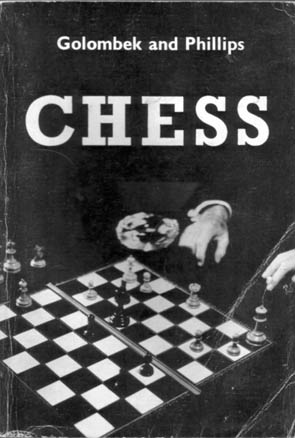
Above is the front cover of the 1964 paperback edition (depicting the famous ‘Indian problem’).
When contacting us by e-mail, correspondents are asked to include their name and full postal address and, when providing information, to quote exact book and magazine sources. The word ‘chess’ needs to appear in the subject-line or in the message itself.
| First column | << previous | Archives [5] | next >> | Current column |
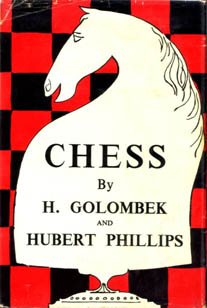
In 1959 a 434-page work, Chess by H. Golombek and H. Phillips, was published at 35 shillings by H.F. & G. Witherby Ltd., London as the third volume in Phillips’ series ‘Compendium of Indoor Games’. It was re-issued as a paperback in 1964, the year after Thomas Y. Crowell Company, New York had brought out a US edition.
The critics received the work coolly. On page 182 of the June 1959 BCM D.J. Morgan (an excellent reviewer who never wrote a chess book himself) described it as ‘a big, highly-priced and comprehensive guide to the game’ which was ‘just another mechanical compilation’. Believing in plain talk and ignoring the fact that he and Golombek were half of the BCM’s editorial team, Morgan expressed his ‘disappointment with a book which has the appearance of having been all too easy in the making’.
Up in Sutton Coldfield, B.H. Wood (CHESS, July 1959, inside front cover) was hardly more impressed:
‘This book has little to commend it except its size. It aims to cater for the absolute beginner in the opening paragraphs and for near-masters later; but we could name many alternative groups of, say, three books which cover the same ground better and cost less in the aggregate.
At the same time, if you do like everything under one cover and don’t mind pools of empty space, this is a book as reliable as all-embracing, containing oceans of good chess.’

Above is the front cover of the 1964 paperback edition (depicting the famous ‘Indian problem’).
In his Foreword Phillips explained why he had not prepared the book alone:
‘My original intention was to write a volume on chess which would be adequate from the beginner’s point of view, though it might not contain much that was original in the way of comment or analysis. But, while I can claim to be an authority on most of the games included in my other volumes (and, indeed, the inventor of many of them) I cannot claim, in the same sense, to be an authority on chess.’
As will become evident below, Phillips (then in his late sixties) was being modest about his familiarity with the game. His writing style and outlook were so different from Golombek’s that it is hard to imagine how a co-production could have worked satisfactorily, and hard too not to regret that Phillips never wrote a chess monograph of his own (with, perhaps, some behind-the-scenes technical assistance). Certainly the desiccated style of Chess bears the stamp of Golombek. The book is seldom referred to today and, indeed, Phillips’ name has never been closely associated with chess; when he died, in 1964, the BCM, for instance, carried no obituary of him, even though he was a prominent writer and broadcaster whose non-chess works (most notably his puzzle books) often had considerable chess content. His autobiography, published in 1960, had, moreover, revealed the extent of his love of chess: ‘it’s my favourite game, and always has been’.
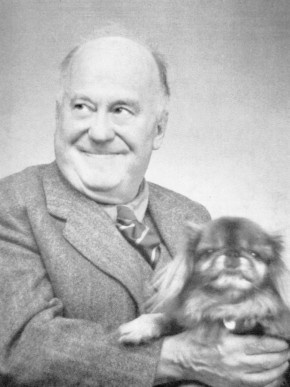
Hubert Phillips
As a ‘puzzlist’, Hubert Phillips had few rivals. He penned dozens
of quiz books, and in The Week-end Problems Book (London,
1932) he included a 29-page chapter on ‘Chess Problems’ (forced
mates and retrograde analysis). He wrote with particular authority
on card games, and in 1957 he edited the English edition of Culbertson’s
Card Games Complete with Official Rules. One of his
best-sellers was The Pan Book of Card Games. On bridge he
was notably prolific and co-authored books with Terence Reese.
Phillips captained the English contract bridge team in 1937 and
1938 and was at one time President of the National Bridge
Association and the editor of British Bridge World. In
1960 he brought out a 224-page monograph Profitable Poker.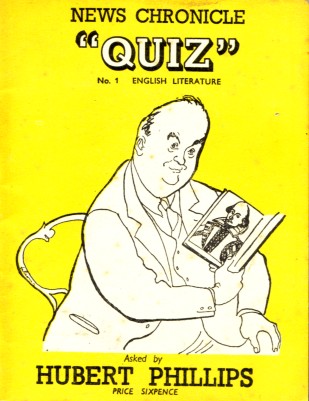
His books for children included The Playtime Omnibus (London, 1933), ‘a miscellany for young people’ in which he revelled in acrostagrams, cryptograms, duograms, skiagrams, tetragrams and so much else in an anthology which, even today, provides an entertaining challenge to readers of any age. A later compendium, The Hubert Phillips Annual 1951, was, in his view at the time, the best thing he had done. His versatility was astonishing. In 1951 he wrote and published (‘A Hubert Phillips Production’) Charles, comprising potted biographies of celebrated figures so named, from the Holy Roman Empire on until ‘Prince Charles of Great Britain’ (born 1948). He wrote fiction, including over two hundred crime stories under pseudonyms. He was a poet, specializing in light compositions, and in 1960 he brought out an anthology, Selected Verse. For eight years he was ‘Caliban’ in the New Statesman, and he conducted a satirical column ‘Dogberry’ in the News Chronicle for over 20 years. He thrived on games, riddles, enigmas, codes, crosswords and every kind of word-game imaginable, arithmetical tricks, quirks of logic and general knowledge quizzes. One of his collections of crossword puzzles was published by Penguin in 1947 under the title Chipwinkle and began with an ingenious spoof biography of Eugene Chipwinkle, ‘the father of the crossword’. His Foreword to Who Wrote That?, from the same publisher the following year, expressed a principle sometimes disregarded today: ‘I have always maintained that there is no point in any kind of quiz unless the questions asked are of interest in themselves.’
Hubert Phillips (1891-1964) gained a first-class degree in history and economics at Merton College, Oxford, just prior to the Great War. He was wounded in action not long before the Armistice. His academic career included, from 1919 to 1924, the post of Head of the Department of Economics at Bristol University, and his interest in politics led to his being Secretary and Adviser to the Liberal Parliamentary Party from 1927 to 1929. Later he turned to journalism and, later still, to both radio and television, becoming, in particular, a regular contestant on BBC Radio’s Round Britain Quiz, a programme which it is tempting to describe as ‘highbrow’, except that on page 164 of his book Party Games (London, 1952) Phillips wrote:
‘I coined the word “mezzobrow” about 30 years ago to designate the many people of the highest intelligence who enjoy such things as crosswords, chess problems, inferential puzzles and parlour games. They differ from “highbrows” in that no self-respecting highbrow solves puzzles or plays parlour games at all. To do so would sadly diminish his status in the eyes of his associates.’
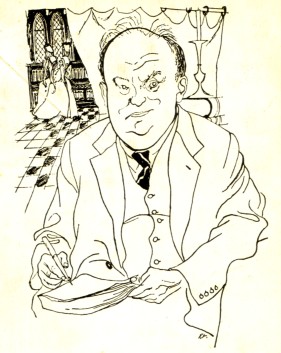
Hubert Phillips
The extent of Phillips’ devotion to chess and his ability, too, to curb the passion were revealed by his ‘discursive autobiography’ Journey to Nowhere (London, 1960). About his university days he wrote on pages 107-108:
‘I had made up my mind (before I went up) that I’d play chess for Oxford against Cambridge.
This ambition, at least, I could have realized without any difficulty. But it went west, along with the others.
“But, excuse me one moment”, said a friend when, years later, I was making this point, “what makes you suppose that you could have played chess for Oxford?”
“That’s easily answered. Comparison of form. In my last year there was no competition for the Oxford County Championship. Instead, there was held a sort of reserve championship, for which, I believe, all the University players entered. I entered too, and took second place: half a point behind my friend George Carruthers (I drew my game against him). And do you know why I didn’t take first place?”
“Of course I don’t.”
“Because of my congenital soft-heartedness. I had won most of the 11 games I played by making my initial moves very quickly. Plonk; Plonk; down went my clock. After eight moves or so, I was playing almost wholly in my opponent’s time. An advantage so gained tells increasingly in one’s favour. One’s opponent finds, at a critical moment, that he has almost no time left and, almost invariably, blunders.”
“How unsportsmanlike, Hubert.”
“Unsportsmanlike? Fiddlesticks. ... Anyway, my last game was against a poorish player who knew all about my spoiling tactics. And, when we met, the first thing he asked me was whether I’d mind not having clocks. He said they put him off.”
“And you agreed?”
“Of course. I said Yes, as I’ve often said Yes when I ought to have said No. For one thing, to waive a rule isn’t fair to other competitors. ... To cut a long story short, I lost the game through sheer boredom. There were times when I thought my opponent was never going to move at all. And that was the only game I lost.”
“But I’m still puzzled. Surely you’d met all those other players before the tournament began?”
“Not at all. I’d only met George Carruthers. You see, I never joined the University Chess Club.”
“Whyever not?”
“I thought it a waste of time. I’d found so many other amusing things to do.”
“Wasn’t that rather resented by the chess people?”
“Yes, I think it was. They regarded me as a renegade. But who wants to go to Oxford – Oxford, where the whole panorama of the mind is deployed for one’s enjoyment – to spend night after night playing chess? It’s my favourite game, and always has been. Why, I’m writing a book on chess at this very moment; I mean to say, we are, Harry Golombek and I. But, at Oxford, chess – like so many other enjoyments – should surely be just one smallish element of one’s personal kaleidoscope. That’s how I saw the thing, anyway; that’s how I see it still.”
“For once”, said she, “I think that you were right.”’
Phillips’ memoirs contained other references to Carruthers. From pages 110-111:
‘George Carruthers was reading chemistry. I was drawn to him not only by our common interest in chess – until I got to know more people we played a game or two several nights a week – by his modesty; his self-effacing manner; and his solitariness, which paralleled my own. ... Most men of our year weren’t interested in chemistry, just as they weren’t interested in chess; but I knew just enough about chemistry to enjoy discussing it with Carruthers, and just enough about chess to give him a good game. He was better than I, but only fractionally better; he won maybe three games out of five. Every Sunday morning we paced round Addison’s Walk, playing a game “blindfold”.
... George Carruthers could just get by. He had, I think, about £120 a year; he must have been the hardest-up man in college. He had dark poky rooms in one of the Mob Quad attics, furnished only with half a dozen textbooks and his chessboard. I often wondered why he had bothered to come to Oxford. I was still his one intimate friend in Merton at the end of his fourth year.
I was very fond of him. He had a crooked nose; a mild sense of humour; an air of self-deprecation. There was no hint in his speech or bearing of his native Camberwell. Night after night he would come sidling into my room like a crab, in the hope that I’d be free for chess. If I had other friends there he would seldom condescend to stay. He took a second in chemistry; a good enough degree to give him some sort of start in life. That was in the summer of ’14. Had he waited for the war, and joined up, he’d have had, like the rest of us, an odds on chance of survival. But he wasn’t even vouchsafed that chance. A few weeks before the war began he died of erysipelas.
What a sad, wasted life, I thought, as I read the letter from Carruthers’ friend and former schoolfellow, Bryant of Corpus. At 22, one did not expect one’s contemporaries to die. Challenge and adventure, surely, lay ahead of us; all the fun and games in the world.
And a few weeks later most of us were in khaki.’
George Carruthers was a member of the Oxford University team against Cambridge University in 1912, 1913, and 1914, with a score of two wins and a loss. (Source: page 354 of A Century of British Chess by P.W. Sergeant.) The defeat was published on pages 284-285 of the July 1914 Chess Amateur.
On page 162 of his autobiography Phillips wrote concerning his fourth year at Oxford:
‘I played bridge about four nights a week and, returning to an earlier and more exacting love, played also a good deal of chess. George Carruthers had not yet taken his Finals. By this time a pillar of the University Chess Club, which – sensibly, I think – I had declined to join, he introduced me to other players of his calibre: I remember particularly the hospitable Davies of Pembroke, in whose rooms we foregathered. Several Merton men played chess of a sort; in my last term it became, for a short time, a minor cult in the college. I organized a team of ten or 12 players – there may even have been more – and we challenged Oxford City to a match. The City club, although warned that we were, to put it mildly, weak, wasn’t taking any chances. They fielded a strong side, including several county players. This contest, which I still recall with amusement, was not so much a match as a massacre. Carruthers won his game on Board 1; I drew mine on Board 2. The rest of the team were sitting ducks. Before I had made my fourth move one of my players had been mated. “Do you really mean”, he was asking plaintively, “that we only play one game?” After that, Merton’s enthusiasm for chess suffered something of a setback.’
Page 241 described activity during his military training:
‘My series of elementary war games, concluding with the last full-scale exercise, served their purpose, I think. Morale was high; we were not unhopeful that reports of our preparedness for action would filter through to the War Office. But, as usual, nothing happened. We were thrust back again into the familiar slough of uncertainty and dither.
The effort that I put into working out my games was not, however, wholly wasted. I have recently popularized in two of my books – my Penguin Hoyle and Games of Skill for Two – varieties of Kriegsspiel which had their origin in the problems which I sought to solve at Welbeck.
Indeed, it was here, under canvas, that one of my games – a modification of chess Kriegsspiel – was played for the first time. Several officers of my unit were interested in chess; eight or nine of us in all. We devised a chess game where each player makes his moves in the dark, under the superintendence of an umpire who can, of course, see both boards. But it differs from chess Kriegsspiel, as normally played, in that – before the game begins – each player sets up his pieces, on his own half of the board, anywhere he pleases. All the information given him is the position of his opponent’s king. One would imagine that such a game would be a pure gamble, and certainly there is in it, as in war, an element of chance. A haphazard move by a scatter-brained opponent may polish off one’s queen. But the element of luck is minute compared with the element of skill; the better player will win, and will win in terms of a well-planned combination, nine times out of ten.’
Our collection contains half a dozen books inscribed by Hubert Phillips, including the following, on yet another of his interests and specialities:
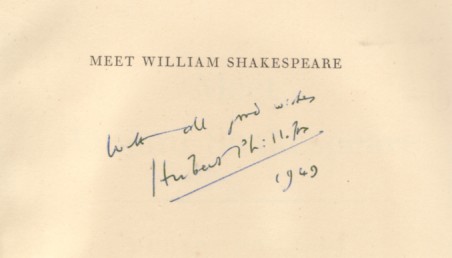
There will be more about, and from, Phillips in future items, but the present one ends with another of his puzzles. It will be left open here for about a week and, although we shall no longer be publishing solvers’ names, news from readers about how they fare will always be welcome.
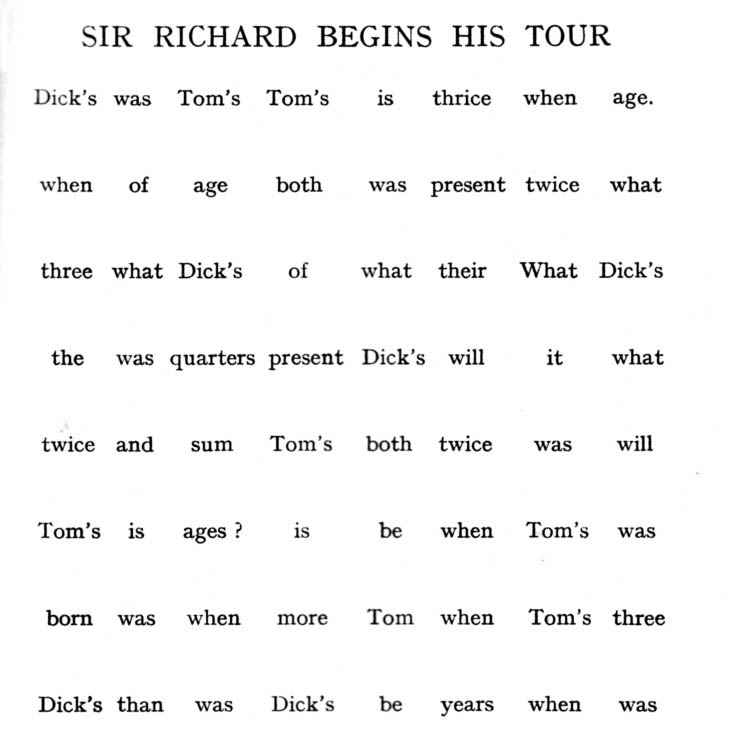

C.N. 2548 (see pages 263-271 of A Chess Omnibus) quoted the Daily Telegraph’s report on a speech entitled ‘The literary associations of chess’ by Sir John Simon (1873-1954) to the Authors’ Club in London on 29 November 1926. Now we give the politician’s own full words, culled from pages 280-285 of his book Comments and Criticisms (London, 1930):
‘Facing this expert company, I feel rather like Mr Winkle when he was invited to exhibit his skill on skates, and I cannot be too grateful that the Authors’ Club does not require me, as the price of my entertainment, to play an exhibition game of chess. It is much safer to talk about it, and there is one aspect of chess very suitable to be considered by a meeting of the Authors’ Club – what is the place which chess occupies in literature? How far does the literature of our own tongue recognize the position that this entrancing pastime occupies among the entertainments of mankind?
Considering the antiquity of the game, considering the affection with which it has been regarded by so many remarkable persons, considering the claim commonly put forward by the most insignificant chessplayer who has just won a match that real skill in the game is – as in the case of Napoleon – proof of the command of military strategy of the highest order – considering all these things, it is very remarkable how comparatively small is the part which chess appears to take in the literature of our country. I am not talking about the large collection of books devoted to expounding the game – “books”, as Charles Lamb said, “which are no books” – but am rather considering how far the imaginative writers in prose or verse have found this occupation a suitable topic to introduce into their delightful works.
Shakespeare, of course, did introduce it. Indeed, the stage direction in The Tempest, where the scene opens with Miranda and Ferdinand engaged in a game of chess, is one of the very few Shakespearean stage directions that are not immediately and vitally connected with the action, though it explains the conversation which follows.
I doubt whether Shakespeare understood chess. At any rate, it is very unusual for two players in the course of their first encounter to address each other thus:
“Mir. – Sweet Lord, you play me false.
Fer. – No, my dearest dear, I would not for the world.”
Now if Bacon played chess, and Shakespeare didn’t, what light would this throw on the Baconian controversy?
But it is rather remarkable that, on the whole, literature contains so few references to the game of chess. Of course, there is the famous instance with which the name of Lewis Carroll will ever be associated, although I have never been able to understand the moves in that particular game. But what opportunities have been missed by others. What a pity it is that one of our literary gentlemen has not made the game of chess as prominent in his romances as Surtees made the pastime of fox-hunting. Why is there no lyric which runs:
“O mystic chess, half instinct and half grind!
And all a pleasure and a wild surprise.”Why is it that no sonnet-writer has described his feelings on a particular occasion by confessing:
“Then felt I like some critic of the game
When a new gambit swims into his ken.”Then what a sad failure to make use of the proper opportunity is exhibited by the more emotional of our journalists. What could the Church Times do with the headlines, “Persistent Attack upon a Black Bishop”. What loyal fervour could the Morning Post work up by describing the “gracious act of her Majesty the Queen in defending an isolated pawn”. What a reputation might be made by the author of a new scenario for the film if the title was “A Knight’s Suicide”, featuring Charlie-Muzio.
Yes, it is certainly remarkable that chess does not take a bigger place in literature, because it is a great game. It has associated with it as continuous and as remarkable a series of examples of a particular kind of skill as any game one can pick. Think of the Syracusan, Paulo [sic] Boi, who exhibited such accomplishment in chess that, finding no worthy opponent in his own country, he made a lengthy tour throughout Christendom, encountered and defeated the great Ruy López himself, and was patronized and rewarded for his prowess by King Sebastian of Portugal and by Catharine de Medici.
Think of that marvellous boy, the Chatterton of chess, Paul Morphy, of New Orleans, who from the age of ten showed amazing aptitude in the game, and won a first prize in a major tournament at New York at the age of 21 [sic]. He came to Europe 70 years ago, defeated the strongest players in London and Paris, returned to his own country, abandoned chess for the profession of advocacy in the law courts, was never heard of in his new occupation, and after only partially recovering from an attack of insanity, died miserably at the age of 47. What a warning to us all to stick to the job we do best.
But although chess is a most exhilarating and amusing occupation, there is a sense in which it is not a game at all. Mr Bonar Law – who always managed to find time to play a game of chess, without in the least failing in the discharge of his full duty to the State – was accustomed to describe chess as “a cold bath for the mind” – which, in these degenerate days, is a very useful stimulant. What is the relation between strategy and tactics in chess? What are the qualities of mind and temperament most necessary for the game? For the game of advocacy one wants a good digestion, a good temper, and a good clerk; and of these three the greatest is the good clerk. But in chess playing I have a suspicion that there is more of psychological influence than some people suppose.
There are people who beat you before the game begins by the confident way in which they arrange the pieces, by the authority with which they make a move, almost by the way they look out of the window or drum their fingers while they are waiting for you to play.
In nearly all games there is always an element of judgment and an element of execution. The game in which those two elements are most equally balanced, perhaps, is the game of croquet. But chess has the very odd quality that the executive element consists in nothing more than picking up a little wooden image and moving it, consistently with the rules of the game, to some other square. Chess, therefore, is a game in which the element of judgment is the overwhelming element from the first moment to the last. Though in chess, too, there is an element of luck. I mean that, for all but the greatest masters, the strength or weakness of our combination is not fully planned or appreciated in advance, and sometimes is much better (or worse) than we intended or expected. But there is no rule of chess that the winner must confess that he builded better than he knew.’
The posts held by Sir John Simon in the British Government included Attorney General, Home Secretary, Foreign Secretary, Chancellor of the Exchequer and Lord Chancellor. Here is his inscription in our copy of Comments and Criticisms:
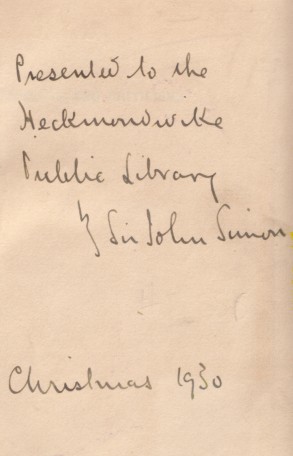
From Peter Lobbenberg (London):
‘In C.N. 3527 you reproduced a note from Fritz Sämisch to “dem glücklichen Schachehepaar Hans und Annemarie Lobbenberg [?] mit herzlichsten Grüssen aus Karlsbad” and you added that the recipients’ name was unclear. I confirm that Hans and Annemarie were my parents, and you have indeed read the surname correctly. Sämisch was my father’s best man at their wedding in Berlin in 1934. There is some further information on my father at http://www.shropshirechess.org/History/1940s.htm.’
Below is a photograph of the participants in Spa, 1926:
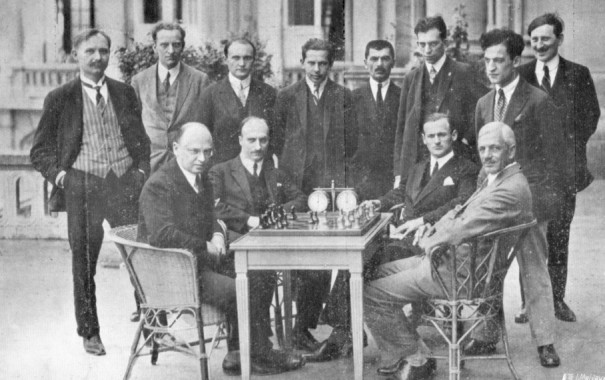
From left to right (standing): A. Lenglez, M.
Varlin, A. Tackels, A. Dunkelblum, V. Soultanbéieff, I.
Censer, G. Koltanowski, J. Davidson.
Seated: S. Tartakower, M. Romih, F. Sämisch, Sir George
Thomas.
C.N. 3551 promised more on Hubert Phillips. Despite being nicknamed the ‘One Man Brains Trust’, he was unassuming and wrote in the Foreword to Hubert Phillips Asks You (London, 1960) that erudition was ‘about the last quality to which I can properly lay claim’. Readers can judge for themselves, for many of his books are still in print, while others are available at low cost second-hand (although some of his earlier works are now very scarce). Below are six further Phillips problems with a chess theme, and it is worth noting first a remark he made on page ix of his book Brush Up Your Wits (London, 1936):
‘The problem-maker’s art is to make what is essentially simple look difficult; the problem-solver’s art is to strip the composition of its pretence and, by bringing a trained faculty to bear, to seek out, with as little wasted effort as possible, the simple elements that constitute the “mystery”.’
Whether that applies to all the puzzles below (the fifth one may be found particularly difficult) is another point on which readers will have their own views.
1. ‘The Chess Tournament
“For the purposes of our chess tournament”, said Woodpusher, “we divided our players into two groups. Each player played two games against each other player in his group. That did away with all possibility of unfairness in regard to the opening move.”
“There must have been a large number of games played altogether.”
“Exactly 200”, said Woodpusher.
How many players in all took part in the tournament?’
Source: Problem Omnibus Volume 1 by H. Phillips (London, 1960), page 73.
For solution click here.
2. ‘Chess
Representatives of Doomshire and Gloomshire met to play chess over 100 boards. Both men and women players took part; each county producing more than 50 men players.
More women played for Gloomshire than for Doomshire.
It was arranged that, so far as possible, men should be matched against men and women against women. This meant that there were only mixed matches (men versus women) to the extent to which the number of men players representing Doomshire exceeded the number of men representing Gloomshire.
On the boards where men were matched against men, Doomshire won three matches out of five. On the boards where women were matched against women, Gloomshire won two matches out of three. And on the boards where Doomshire’s surplus men met Gloomshire’s surplus women, the Doomshire players won two-thirds of the matches. No game ended in a draw. The result was a very narrow win for Doomshire by 51 games to 49.
How many men played for Doomshire?’
Sources: The Hubert Phillips Annual 1951 (London, 1950), page 160 and Problem Omnibus Volume 1 by H. Phillips (London, 1960), page 87.
For solution click here.
3. ‘Giuoco Piano
“I’m competing”, said Gambitt, “in the Minor Open Reserves at Prawnville.”
“Oh yes? Do you expect to win a prize?”
“Can’t say. There are four prizes altogether.”
“And how many competitors?”
“Twelve. But of course they may divide one or more of the prizes. Scoring is on the usual plan, you see: one point for a win, half a point for a draw. One year all 12 competitors scored five and a half points; the four prizes were divided among them. Last year three competitors tied for first place – they shared the first three prizes – then came three more competitors with equal points; they divided the fourth place. So, you see, there’s always a chance.”
“If I were you, Gambitt”, I said, “I wouldn’t be too ambitious. Aim at scoring just enough points to be certain of at least a share in a prize.”
“Good idea”, said Gambitt, “but how many points is that?”
How many points is it?’
Source: Problem Omnibus Volume 1 by H. Phillips (London, 1960), pages 114-115.
For solution click here.
4. ‘Wrong number
When Mrs Orme went into the nursery the children were playing with the chessmen.
“What are you doing, dears?”
“Why”, said Ronnie, “Clara and I were talking about our phone number. Clara says it has 32 pairs of factors.”
“So it has”, said Mrs Orme, who had worked that out herself. “But why the chessmen?”
“There are 32 of those”, said Ronnie. “I was putting one back in the box as I worked each pair of factors out. But, Mummy, there’s something wrong. I’ve finished my calculations, and there are still these eight black pawns.”
Mrs Orme took a hasty glance at his notebook. “Ronnie”, she said, “you are a duffer. You’ve got the number wrong.”
“Got the number wrong?” echoed Ronnie.
“Of course. You wouldn’t call yourself Rome, now would you?”
What is the Ormes’s phone number?’
Source: Problem Omnibus Volume 1 by H. Phillips (London, 1960), pages 119-120.
For solution click here.
5. ‘Secret Service
During the recent rebellion in Jehannum, a native runner was brought into the small fortified station of Ustaraf, which was occupied by a detachment of the Wellshires, and was found to be carrying in the folds of his pagri a tightly-folded paper, which he gave up without demur. The only writing on it was the following:
Major ffeatherstonehaugh-Haugh, a keen but incompetent chessplayer, who was in command, was greatly interested, and guessed that it must be a chess problem sent to him by Legge-Pullar, who had taught him the rudiments of the game, and whom he knew to be on Intelligence duty somewhere in the interior. He therefore set himself to solve the problem, which seemed to be rather unusual; so unusual, in fact, that three days later he had made nothing of it when another runner was brought in, bearing a paper on which the following was written:
AHAMIT TOT THAR TINALI EFAI ETCHL KRPS SOTTURA EPASTAI APONRR NIWDSIN IHLGT.
Major ffeatherstonehaugh-Haugh regrets he is unable to make head or tail of this, and begs you to translate it for him, as he is not familiar with any Oriental language.’
Source: Caliban’s Problem Book by H. Phillips (‘Caliban’), S.T. Shovelton and G. Struan Marshall (London, 1933), pages 59-60.
For solution click here.
6. ‘Eques enucleat castaneam
When I met Professor Graeme Atta the other day he showed me an interesting old manuscript book which he had come across when he was browsing among the second-hand bookstalls in Charing Cross Road. The book plate was almost indecipherable, but as far as I could make out bore the inscription “ex libris Samueli Loyd”. One of the pages contained a curious Latin cryptogram which seems to be of more than passing interest. Here is a copy of it:
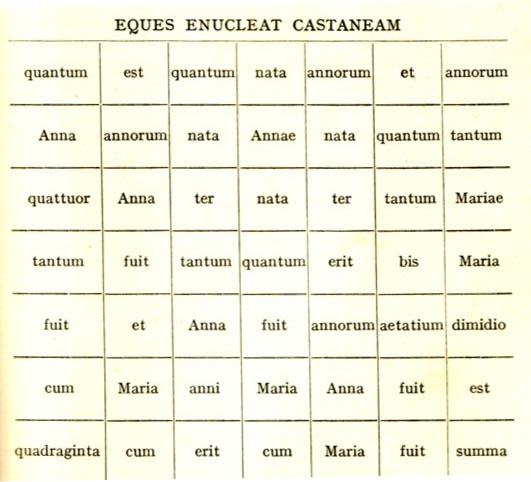
Quot annos nata est Maria?’
Source: Caliban’s Problem Book by H. Phillips (‘Caliban’), S.T. Shovelton and G. Struan Marshall (London, 1933), page 127.
For solution click here.
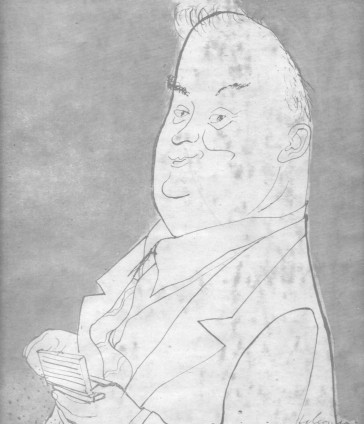
Hubert Phillips
C.N. 3551 quoted Phillips’ remarks about his adaptation of Kriegspiel (he preferred the alternative spelling Kriegsspiel), and we shall give now a game from his book The Penguin Hoyle (Harmondsworth, 1958). First, though, from page vii comes this further comment on his variant:
‘Here is a game which, once you have mastered its rules, can be played with as much enjoyment by novices as by those who have devoted years to the study of chess theory. I have played, or umpired, hundreds of games of Kriegsspiel, and can’t recall one that wasn’t exciting as well as being good for a laugh. There’s an element of luck in the game, but a great deal of skill too; the better of two players will win nine times out of ten.’
Page 272 had a game which ‘was given to me by the Umpire who gleefully recorded the moves’:
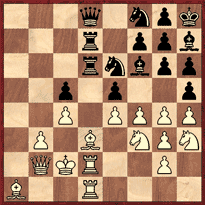
1 g5 hxg5 2 hxg5 Bxg5 3 fxg5 Nxg5 4 Nhxg5 Qxg5 (‘Rash.’) 5 Nxg5 f6 6 Rf1 fxg5 7 Rdf2 g4 8 Rxf8 Rf6 9 Ra8 (‘Exploratory’) 9...Rdf7 10 Qxe5 Rf8 11 Rxf8 Rxf8 12 Rxf8 h4 13 gxh4 g3

‘White, who has a fair idea of the position, can now of course mate by Qxg7. But White did not want to jeopardize his queen; he decided to play Bg7, hoping that this might effect mate. So, to make way for the bishop, he played 14 Qg5. Stalemate.’
For further information on Kriegspiel and Phillips, see the
entry on pages 165-169 of The Encyclopedia of Chess Variants
by D.B. Pritchard (Godalming, 1994) and, in particular, the list
of variants at the end of that entry (e.g. Welbeck Kriegspiel).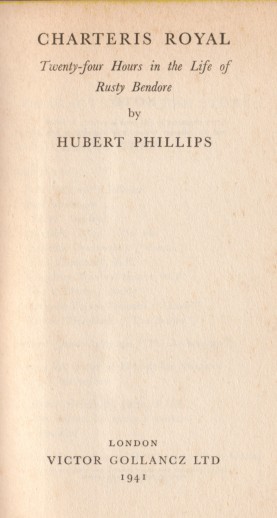
Finally in this miscellany, page 534 of Chess An Annotated Bibliography of Works Published in the English Language 1850-1968 by Douglas A. Betts (Boston, 1974) listed, without any details, a second book by Hubert Phillips (i.e. in addition to the co-production with Golombek): a work of fiction entitled Charteris Royal (London, 1941). However, Betts had commented in his introduction (page xiv) that for entries in the Bibliography’s fiction section ‘the chess content may be minimal’, and we note that such is indeed the case with Charteris Royal. A 253-page novel, it contains passing references to chess, but the only passage of any length or substance is on page 46:
‘Chaim was 57. A mathematician of exceptional calibre, his eyesight had failed him while he was still an undergraduate at Cambridge. He took refuge for a few years in a College tutorship; but when, on his father’s death, he came into a small private income, he gave up a task for which he felt himself ill-equipped and found an outlet for his energies in chess.
Within four or five years, he was admitted to the ranks of the masters. He won the tournament at San Marino, a few years before the war [i.e. the First World War], and took third place in the big Congress at Kronsberg, where he was led only by Capablanca and Tarrasch. His reputation, in this exclusive field, seemed assured.
Now, however, came the war; and with it a fresh orientation of Chaim’s interests. Like all great chessplayers, he had studied the technique of analysis, as a thing apart from the mere trappings of the game. His mind, as he had once explained to Rusty, functioned as a sort of prism, breaking up any problem, more or less automatically, into its logical constituents.’
‘“All bridge and chess players are slightly cuckoo.” – Ely Culbertson, bridge expert.’
The above quotation (the fors and againsts of which we cagily pass over) appeared on page 313 of CHESS, 14 May 1939. No source was given, and it is thus difficult to determine whether Culbertson did make such a remark and, if so, in which context. We recall no observation of the kind in his lengthy (and unindexed) autobiography, The Strange Lives of One Man (Chicago, 1940), although it does contain several references to chess.
The best known of these is too familiar to be repeated here: Culbertson’s account of Emanuel Lasker’s application to him for a teaching certificate for bridge. It appeared on pages 552-553 of the book and has been reproduced a number of times (e.g. by D.J. Morgan on page 460 of the October 1975 BCM).
Ely Culbertson (1891-1955) was in Paris during the First World War and wrote on pages 335-336 of his book:
‘Cards and card games, long my favorite pastime, now became the subject of scientific experiment. I was fascinated by cards – their origin, their structure (so similar to that of their cousin, chess); and their bizarre world, with its own logic and abstractions.
Thus I lived for nearly two years in my ivory tower, growing more learned but more morbid. I had few outside interests, no friends. Occasionally I played chess, bridge and poker ...’
From pages 386-387:
‘Within a few weeks I accumulated enough money to move over to a game of plafond at the Café [de la] Régence, which was and still is a famous chess center. There Bonar Law, who was later Prime Minister of England, used to play chess with Russian revolutionists; and Isaac Rice, the father-in-law of P. Hal Sims, used to bend all his energies and spend a great deal of money with chess professionals in propaganda for the Rice Gambit.’
Below is the inscription by Culbertson in our copy of The Strange Lives of One Man:
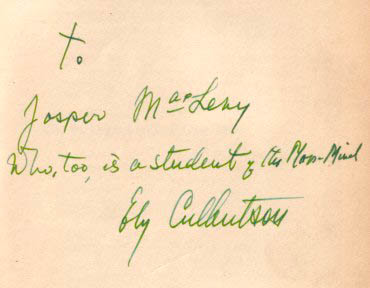
The following passage appeared on pages 416-417 and relates to
the early 1920s:
‘I had occasionally dropped in at Frank Marshall’s Chess Club for a game of chess. There I had watched a bridge game which ran daily at half a cent a point. The bidding and play were atrocious, and I had often reflected that even at half a cent a point I should easily make a couple of hundred dollars a month ...
... I took a Fifth Avenue bus for my first hunting expedition in Greenwich Village.
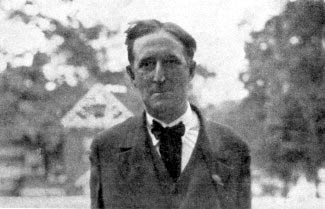
Frank Marshall and his charming wife greeted me cordially. Instead of playing chess, however, I asked if I could cut in at a bridge table.
“Do you play auction?” Everyone was surprised.
“A little.”
I was received with that naïve alacrity peculiar to many bridge players, who regard every stranger as a customer. Their hopes were amply confirmed as I started to play. Such bizarre, unconventional, crazy bidding had never been seen before.
No wonder – I was the only player in the world who then played the Culbertson System.
That night Janowsky, one of the world’s greatest chess champions, who also fancied himself a master at auction, was playing at my table. His luck was running badly, and he suggested that we double the stakes and play for a penny. Since everyone was already playing on Janowsky’s losses, it was agreed; and later we doubled the stakes again. We played all night. I had never worked harder nor played better. When the game broke up at ten in the morning I had won a hundred dollars, most of it from Janowsky. He told me he would pay me the next day. That was all right. But the next day he died.
I went on playing at Marshall’s, but the cards began to run against me. Day after day I lost; and my capital dwindled to less than ten dollars ...
My luck finally turned, and in a short time I regained my losses. From then on I seldom had a losing week, but at half a cent a point it was impossible to squeeze out more than an average of 150 dollars a month.’
A substantial problem with Culbertson’s story is that Janowsky died in Hyères, France, in 1927.
Still concerning bridge, the famous challenge match in 1931-32 between Culbertson and Sidney Lenz was discussed in detail. Culbertson won decisively, and page 601 had the following quotation from an article by Robert Neville about the concluding social festivities hosted by Culbertson for the press:
‘After the dinner, for a change, bridge was played. Mr Culbertson played incognito. Mr Lenz went back to his golf, his ping-pong, his magic, his camelot and his chess with José R. Capablanca.’
Pages 610-612 discussed the July 1933 bridge world championship match in London against a team headed by ‘Pops’ Beasley and the production by the News Chronicle of an ‘instant’ 400-page hardback thereon (within 36 hours of the last hand being played). This takes us back to Hubert Phillips’ autobiography, Journey to Nowhere (London, 1960) and a passage on pages 260-261 regarding the same period (which, however, Phillips dated 1932):
‘I am also the News Chronicle’s bridge expert, and in that capacity am rounding off my story of the much-ballyhoo’d Culbertson-Beasley match, which, played at Selfridges before a milling crowd of kibitzers, had ended, in Culbertson’s favour, in the small hours of the morning. It was I who, two years before, had arranged in New York the details of Ely Culbertson’s first visit to this country; and since then I have edited the English version of his Blue Book and have acted as his representative in negotiations with publishers and so on.’
It was on this occasion that Culbertson invited Phillips to edit the English edition of Culbertson’s magazine, Bridge World.
With a brief mention that pages 92-96 of Hubert Phillips’s Heptameron (London, 1945) contained a discussion of the Culbertson v Lenz match (‘the bridge battle of the century’) we bring this item to an end, before it strays from chess even more than intended.
From Julia Walworth (Research Fellow and Librarian, Merton College, Oxford):
‘The information in the Merton College Register is rather sparse: George Carruthers was born on 29 July 1891. He was educated at Wilson’s Grammar School in Camberwell; he was a student in Chemistry at Merton from 1910 to 1913, and was a Postmaster (the Merton equivalent of Scholar). In 1913 Carruthers received his B.A. A date of death is not recorded.’
We are also grateful to Alice Millea, Assistant Keeper of the Archives, Bodleian Library, Oxford, who writes:
‘George Carruthers matriculated (was admitted to the University) on 18 October 1910 from Merton College. According to the form which he completed at matriculation, he was born on 29 July 1891 in Camberwell, Surrey, the first son of Francis James Carruthers, a “cashier” by that time deceased. He was educated at Wilson’s Grammar School, Camberwell. He obtained his B.A. on 2 August 1913, achieving second-class honours in Chemistry. Deaths of University members were (and are) published in the University Gazette. I have checked the Gazette for 1914 but have found no record of the death of Carruthers.’
No reader identified the chess figure in the photograph. It was
D.W. Fiske, who was standing on the right, alongside Michele
Monzecchi and Enrico Stella. We reproduced the picture from Willard
Fiske Life and Correspondence by H.S. White (New York,
1925), and below is another shot of Fiske on the same page:
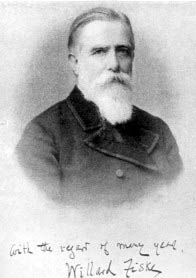
As mentioned in C.N. 2495, information is lacking about Frederick D. Rosebault, who was briefly Capablanca’s business associate and was involved in the Cuban’s failed attempts to secure a world championship match against Lasker in 1911-12. See page 358 of A Chess Omnibus, as well as various references to Rosebault in our book on Capablanca. In late 1912 the Capablanca-Rosebault partnership sustained a series of setbacks: the aborted world title negotiations, the failure of the planned New York/Havana tournament and the non-appearance of a projected magazine, The Chess Forum, but it is not known for certain why Capablanca broke off his relations with Rosebault that December.
Below, from our collection, is the Capablanca-Rosebault business card:
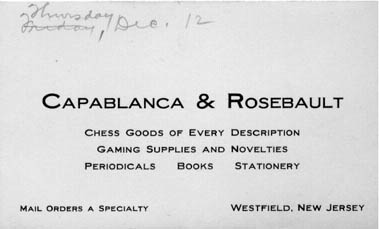
In 1987 we tried to find out more about Rosebault, having noted references to him in chess literature as ‘F.D. Rosebault of Westfield, NJ’. As reported in C.N. 1431, the Westfield Memorial Library informed us that the 1900 archives contained nothing on anybody named Rosebault. However, later city directories gave:
There was no later listing in the directories.
The 1900 census provided some additional information on the Rosebault family:
New York, King’s County, Brooklyn, 359 Jefferson Avenue:
The 1910 census gave the same data, except that the place of residence was Westfield.
C.N. 1461 added that the death of Leonard W. Rosebault, in Cranford, NJ, was reported on page 31 of The New York Times, 19 August 1965. It may be noted now that the US Social Security Death Index (as made available at www.familysearch.org) has his date of birth as 24 March 1886.
The earliest reference we have noted in chess literature to any Rosebault is on page 261 of the July 1905 American Chess Bulletin, which reported on a nine-board match ‘for the interborough scholastic championship of Greater New York’ (Manhattan v Brooklyn). On board three a player named Rosebault (no initial given) from Euclid School scored a draw for Brooklyn.
A key unresolved question has been when F.D. Rosebault died, but while preparing this item we came across the following webpage: http://www.interment.net/data/us/ca/losangeles/lanat/r/lanat_r10.htm
This lists the death of a Frederick D. Rosebault on 16 December 1945, recording that he had been a Private in Company G of the 51st Infantry Regiment, 6th Division. It is unfortunate that no year of birth was stipulated, to settle beyond reasonable doubt whether he was indeed Capablanca’s mysterious business partner.
As mentioned in C.N. 2849, our collection contains two sheets of stationery with Capablanca indicated as the editor of Chess Features, although we lack information about the context (including, even, the exact period).
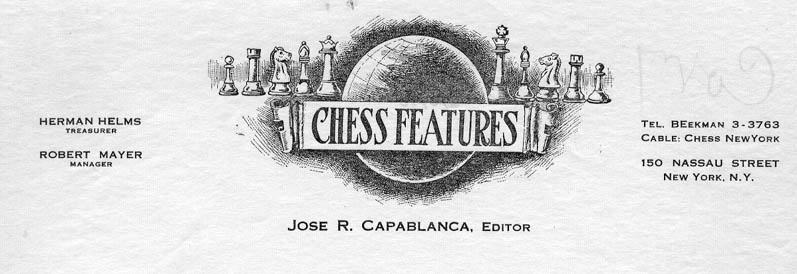
Is the name Robert Mayer a clue? What else is known about Chess Features?

‘Now that the drawing for the Candidates’ Matches has been held, it is a natural thing for everyone to make predictions as to who will end up in the challengers’ [sic] seat next year playing against Boris Spassky of the USSR for the world title.’
So wrote George Koltanowski on page 4 of Chess Digest Magazine, January 1971, although an alternative view is that making public predictions is unnatural, pointless and vulgar. In any case, Koltanowski’s chess judgement resulted in the following declaration on Fischer v Taimanov:
‘I believe it will be a very close match, with Fischer winning it 5½-4½.’
Fischer won 6-0.
More will be said about Koltanowski shortly.
From 1939 to 1945 Hans Frank kept a diary, 11,000 typewritten foolscap pages, comprising 38 volumes, and some of the material has been published over the years. One such publication (from which the above statistics are taken) is Hans Frank’s Diary by S. Piotrowski (Warsaw, 1961). It is a 320-page book, but the diary excerpts do not begin until page 207. No references to chess have been noted, but we wish to ascertain whether Frank’s complete Tagebücher did ever mention Alekhine, Bogoljubow or, more generally, chess under the Nazi regime. Has the matter ever been investigated by, in particular, Polish or German chess researchers?
The Foreword to the above-mentioned book (page 6) states:
‘Hans Frank’s Diary was handed over to the Polish authorities after the close of the Nuremberg trial and is now in the archives of the Ministry of Justice in Warsaw.’
Below is a picture of Hans Frank in gaol following the fall of the Third Reich:
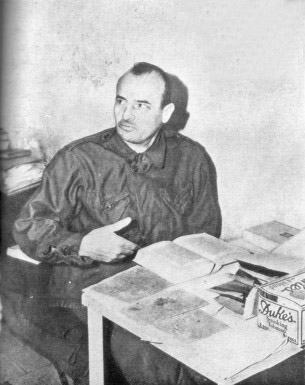
The photograph of D.W. Fiske (see C.Ns 3543 and 3558) has prompted some observations from Calle Erlandsson (Lund, Sweden). The first of them relates to Fiske’s Icelandic chess periodical Í Uppnámi, which was mentioned in C.N. 3205.
‘On the 80th anniversary of Taflfélags Reykjavíkur in 1980 a reprint of volumes 1-2 (1901-02) of the magazine Í Uppnámi (Íslenzkt Skákrit) was issued in 250 numbered copies. (My copy is No. 52.) On the back page of No. 3, volume 2 (1902) there is an advertisement for “Skákdæmakort eptir William Orville Fiske” (five postcards with 17 diagrams [skákdæmum]). The price was ten aurar for one card and 35 aurar for all of them. At the end of Fiske’s entry in the Oxford Companion to Chess there is a brief reference to D.W.F.’s younger brother, William Orville Fiske. What more is known about him?
On pages 71-75 of issue four of volume 1 of Í Uppnámi (1901) an article appears about the chessboard in Grímsey, Iceland. Page 72 has a reference note to Fiske’s Chess in Iceland, pages 68-69. However, I cannot find any trace of this book having been printed before 1905. I have a copy of Fiske’s Chess in Iceland and in Icelandic Literature (Florence, 1905), which is number 250 in the L/N catalogue. Was Chess in Iceland a pre-issue of Chess in Iceland and in Icelandic Literature?’
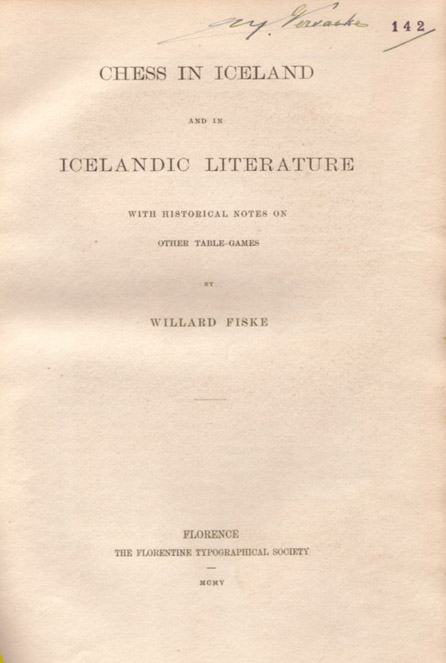
Our correspondent also points out the following Icelandic webpage, with a chess picture on which we would welcome further information: http://www.bok.hi.is/syning/syning08j.htm
There was a reference to W.O. Fiske on page 9 of Willard Fiske Life and Correspondence by H.S. White (New York, 1925):
‘Some mention should be made here of Mr Fiske’s younger brother, William Orville, who was born in 1835 and died in 1909. He had the musical gifts which his elder brother missed and the lack of which he often mourned. A handsome man in his prime, with golden hair and beard. Besides teaching the piano, the organ and singing, and officiating as a musical director, he was for many years the organist of St Mary’s Church in Syracuse, and married the niece of its pastor, Father O’Hara, herself a musician, and soprano in the choir. Earlier, Mr Fiske had held a professorship of music in the Fort Plain Seminary. His musical compositions were many and varied, and of artistic worth. In 1872 Oliver Ditson published a work edited by Mr Fiske entitled The Offertorium, a collection of music for the services of the Catholic Church, comprising masses, vespers, anthems, etc. Mr Fiske himself composed much sacred music, but did not disdain the lighter forms of composition, including marches, waltzes, galops, and other pieces for the piano, as well as songs and choruses. Many of Professor Fiske’s Psi Upsilon verses were set to music by his gifted brother.
William Fiske was a chess enthusiast too, and for a while edited a chess column in the Syracuse Standard, at the time when his brother was editing the New York Chess Monthly; and he also won the first prize at a chess tournament in Syracuse. In E.B. Cook’s great collection of chess problems (New York, 1868), 18 specimens by W.O. Fiske are included, comprising mates in two, three, four and seven moves.
The Boston Waverly Magazine published in its earlier years many of William Fiske’s musical compositions. In Vol. XIV (1857) appeared a “Chess Polka” and in Vol. XVIII (1859) a “Caissa Quickstep”, both inscribed to D.W. Fiske, who is described in the latter as “Editor of the New York Chess Monthly”. The name of the author of these two productions was given as “Guglielmo Orville”, evidently an Italianized pseudonym of the fraternal composer.’
As regards the question at the end of Mr Erlandsson’s contribution, it certainly seems that no book by Fiske entitled Chess in Iceland existed in 1901. Consequently, the most likely explanation for the reference in Í Uppnámi is that the section entitled ‘A Grimsey Legend’ had already been type-set: it may be noted that the specified page numbers of the feature (i.e. 68-69) were as in D.W. Fiske’s posthumous (1905) book Chess in Iceland and in Icelandic Literature.
A drawing of Capablanca which we reproduce from the Finnish newspaper (in Swedish) Dagens Tidning, 21 February 1914:
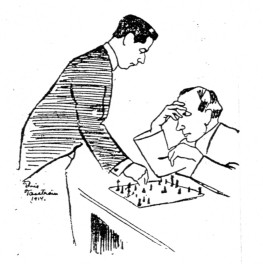
Below is Hubert Phillips’ solution to his puzzle entitled ‘Sir Richard begins his tour’, given at the end of C.N. 3551:
‘From the arrangement of the words of the problem and the hint in the title it should be clear that this is a problem based on the knight’s move in chess. The first word is at the top left-hand corner, and the question reads:
“Dick’s age is twice what Tom’s was when Dick’s was twice what Tom’s was when Dick’s was three years more than Tom’s was when Dick’s was both thrice what it was when Tom was born and three quarters of Tom’s present age. What will Tom’s be when Dick’s is twice what Tom’s will be when Dick’s is the sum of both their present ages?”
The answer to the question is found by assuming that the difference in the ages is x. Then the statement concerning the ages leads at once to the equation
3x = ¾ (8x – 12 – x).
Therefore x = 4, Tom’s age is 16 and Dick’s age is 20. Tom will be 32 when Dick is 36, and when Dick is 64 Tom will be 60.
The solution of the problem is therefore 60 years.’
Source: page 81 and pages 231-232 of Caliban’s Problem Book by Hubert Phillips (‘Caliban’), S.T. Shovelton and G. Struan Marshall (London, 1933).
In front of us lies an openings monograph with a section headed ‘Variante Ovsey-Cotlar’. Which is the opening under discussion, what is the title of the book and why is the variation so named?
The eagerness of writers on chess to snap up, and pass on, items of untrustworthy provenance is a continual source of dismay. We recall a passage from the short story ‘Rumpole and the Blind Tasting’ by John Mortimer (on page 445 of The Second Rumpole Omnibus), where the formidable barrister Horace Rumpole records:
‘The defence of Hugh Snakelegs Timson had not been going particularly well. The standard receiver’s story, “I got the whole lot from a bloke in a pub who was selling them off cheap, and whose name I cannot for the life of me recall”, was treated with undisguised contempt by his Honour, Judge Roger Bullingham ...’
When shady material is disseminated in the chess world, ‘undisguised contempt’ is particularly justified if the raison d’être of such dissemination is to ridicule a chessplayer. Many authors are fond of such mockery, although not all of them manage even to identify their quarry correctly.
C.N.s 2917, 2932 and 3290 discussed the ‘fun’ which various chess writers have had with statements that in the 1930s a player named Frydman, Frydmann or Friedman (and just as many forename variants) had mental health problems. For readers’ convenience, we reproduce those earlier C.N. items here, before adding George Koltanowski’s contribution to the chaos.
C.N. 2917:
From page 79 of the 2002 edition of Chess Lists by A. Soltis:
‘The most tragic case belongs to Paulino Frydman, a little-known Polish master who was invited to the Bad Podĕbrady, Czechoslovakia international of July 1936. Surrounded by several world-class players – including Alexander Alekhine, Salo Flohr, Erich Eliskases and Gideon Stahlberg – he astounded them by allowing only a draw in his first seven games. But two rounds later, with a score of 8-1, he lost to Alekhine and suffered a nervous breakdown. Frydman scored only one and a half points in his last eight games and finished as an also-ran. He was never again a significant figure in chess.’
There were similar words from Sourceless Soltis on page 81 of the 1984 edition of his book. In reality, though, from the field of 18 masters Frydman finished equal sixth with Eliskases, and his significant over-the-board achievements in subsequent years are a matter of public record. As regards the ‘nervous breakdown’ part of the story, it may be wondered if Soltis had any solid information of his own or was merely copying from Wolfgang Heidenfeld’s entry on the Podĕbrady tournament in The Encyclopedia of Chess by Harry Golombek.
Next, a typical Internet item by Bill Wall:
‘Frydman, Paulino (1905-1982)
A leading Polish player during the 1930s who represented his country in seven Olympiads. He used to run around nude in hotels yelling, “fire”.’
Wall writes similarly at another website:
‘Paulino Frydman was a leading Polish player during the 1930s who represented his country in seven olympiads. He used to run around nude in hotels yelling “fire”.’
Or again:
“The Polish master Frydman also ran around nude, but usually in hotels while yelling, “fire”.’
At yet another Internet site, Wall disseminates a slightly dressed-up version of his story:
‘The Polish master Paulino Frydman represented his country in seven chess olympiads. He liked to clear out hotels by running down the halls in his underwear yelling, “Fire!”’
At no stage, of course, has Wall given any further particulars, but a similar tale may be recalled from The Psychology of the Chess Player by Reuben Fine. On page 65 he wrote:
‘During a chess tournament in Poland a Polish master by the name of A. Frydman was reported to have gone berserk and to have run through the hotel without any clothes on shouting “Fire!”’
This may seem strange. We have been repeatedly assured by Wall that the master in question was Paulino Frydman, so why did Fine write ‘A. Frydman’? Moreover, Fine suggests that the incident in question occurred once only, whereas Wall is ostensibly privy to information that it was Frydman’s frequent conduct (i.e. what he ‘used to’ do, ‘liked to’ do and ‘usually’ did). Finally, given that Podĕbrady was in Czechoslovakia and not Poland, where Fine places the tournament in question, how might any of this tie in with Soltis’ reportage?
We note that page 44 of CHESS, 14 October 1937 contained the following piece under the heading ‘What really happened?’
“‘Variations of the following weird theme have appeared in a number of British and American newspapers. We reproduce without comment:
“In a chess tournament at Jurata, Poland, a contestant, Willy Frydmann, lost a game then went raving mad.”’
So now we have ‘Frydmann’ instead of ‘Frydman’ and ‘Willy’ rather than either ‘Paulino’ or ‘A.’.
Pages 197-198 of the July 1937 Deutsche Schachzeitung had a brief account of the Jurata tournament, a 22-man contest in May/June for the Polish championship. It was won by Tartakower ahead of Ståhlberg and Najdorf, and the Deutsche Schachzeitung stated that P. Frydman finished last but two, with 6½ points, having withdrawn after losing in the 15th round and suffering a nervous breakdown. (‘Frydman erlitt, als er in der 15. Runde verlor, einen Nervenzusammenbruch und musste aus dem Turnier ausscheiden.’)
However, the full crosstable of Jurata, 1937 was given on page 374 of the December 1937 Wiener Schachzeitung, and it stated, correctly, that the player who finished 20th was A. Frydman. Earlier (page 152 of the May 1937 issue) the Wiener Schachzeitung had named the player as Achill Frydman and had referred to ‘den tragischen Unfall Achill Frydmans, der mit einer schweren Nervenerkrankung in eine Heilanstalt überführt werden musste’.
Jeremy Gaige’s Chess Personalia lists ‘Achilles Frydman (1905-circa 1940)’, a player with an entry on page 276 of Szachy od A do Z by W. Litmanowicz and J. Giżycki (Warsaw, 1986). Perhaps a Polish correspondent can locate further details. And perhaps – a true long shot, this – one or two writers will consider it appropriate to substantiate their assertions about Paulino Frydman. For our part, we have found no contemporary report mentioning fire, nudity or underwear.
C.N. 2932:
From Tomasz Lissowski (Warsaw):
‘It is true that Achilles Frydman of Łódź (and not the more famous Paulin(o) Frydman of Warsaw, and later of Buenos Aires) had serious health problems in the late 1930s. Two quotations follow, the first being from the column in Polska Zbrojna by Colonel M. Steifer at the time of the Jurata, 1937 tournament:
“Najdorf could have easily won first prize, had it not been for an irritating incident with A. Frydman, who caused many difficulties for the tournament management and for the players. This cost Najdorf two points: the games he lost against Gerstenfeld and Schächter in winning positions.”
Further information is given by Tadeusz Wolsza on page 32 of the third volume of his dictionary of Polish chess players, Arcymistrzowie, mistrzowie, amatorzy:
“Near the end of the tournament Achilles Frydman fell ill. After one of his numerous lost games he was the victim of a strong attack of fury, and doctors placed him in a mental asylum in Kocborowo. This unfortunate case ended his chess career. He never returned to competitive chess, and his occasional off-hand games were only against friends.”’
C.N. 3290:
Christian Sánchez (Rosario, Argentina) refers us to page 10 of the eighth issue of the Spanish magazine Ocho x Ocho Especial (January 1995), in which Román Torán quoted Albéric O’Kelly de Galway as stating that at Łódź, 1938 ‘Friedman’, entirely naked, turned up 15 minutes late for his game against Tartakower. It is not specified where the Belgian master wrote the item attributed to him by Torán.
That is how the matter stood in this column in May 2004, but now we add George Koltanowski’s handling of the affair, from an article entitled ‘People are the craziest!?’ on page 186 of Chess Digest Magazine, August 1971:
‘[L]et me start at the beginning of this true story:
We quote from the Jurata (Poland) morning paper of 11 August 1937:
“In the International Chess tournament of Jurata, 21 of the 22 competitors have suddenly become stark crazy. They have decided to continue with the tournament and finish their 21 games in 14 days. Only one participant was sensible enough to retire to a resthome.” End quote.
The player in question was Anton Frydman, a Pole who a few days before the start of the tournament, had just been released from a Mental Institute and had been warned by the doctors not to play chess for a good while. Yet Frydman persuaded the tournament organizers to allow him to play in the tournament. In the first rounds he played good chess. He managed to draw with Xavier Tartakower, who eventually won the tournament. But the way the chess masters played, NO adjournments, playing two games a day, almost each day, with a total of 12 to 14 hours of mental work daily, sometimes even longer, something had to give.
In the 12th round Frydman started his shenennigans [sic]! During his game with Miguel Najdorf, Frydman ran to the phone after every move, placing long-distance calls collect, ordering such important articles as a bicycle from Germany, a flute from Hungary, etc. The next day he had to be locked up in his room ... he insisted in walking around in the lobby in his Adam’s suit. Gideon Stahlberg, who had the misfortune of having the room next to Frydman, couldn’t sleep at night. His (opponent) next-door neighbor was calling out check and check-mate all night long in a very loud voice.
That was when the committee decided to have Frydman returned to his Resthome ... and the players met to vote if they should continue the tourney under those terrible long hour conditions. They finished the event!’
The ellipses in the above passage are Koltanowski’s.
What he terms ‘this true story’ is just a further example of the Koltanowski drivel-machine at full throttle. He did not participate in the tournament, and the origin of many of his claims is unknown to us. A number of them, however, are contradicted by the details in Four Polish Championships by T. Lissowski (Nottingham, 2003), which gives all available games from Jurata, 1937 and some background information (noting, for instance, that the tournament took place from 23 May to 6 June 1937 and that ‘three games were to be played every two days’). The following points, in particular, may be listed:
a) Although the tournament finished on 6 June, Koltanowski claims to be quoting a topical-sounding newspaper item which he dates over two months later: 11 August 1937. (It may seem ungracious to criticize Koltanowski on a matter where, for once, he attempted to cite a documentary source, but he failed even to name ‘the Jurata (Poland) morning paper of 11 August 1937’ from which he was purportedly quoting.)
b) Koltanowski refers to ‘Anton’ Frydman. His forename was Achilles.
c) Another incorrect statement by Koltanowski is that Frydman drew with Tartakower. In fact, Tartakower won (in round 2).
d) Koltanowski is also wrong to indicate that Frydman’s game against Najdorf was in the 12th round. They met in round 15.
e) Nothing has been found to support Koltanowski’s assertions about Frydman’s withdrawal from the tournament.
Walter B. Hart (Burra Creek, Australia) asks whether the moves of Rosebault’s game against Capablanca in the New York State Tournament on 22 February 1910, one of the very few scores absent from the 1963 Wildhagen volume on the Cuban by J. Gilchrist and D. Hooper, have ever been found.
We believe not. Our correspondent points out that an article by V. Fiala on page 19 of the 4/2000 Quarterly for Chess History stated that Capablanca’s victory was in 40 moves, and we have no information beyond that.
C.N. 3484 discussed Alfred Kreymborg (1883-1966), a strong player and the writer of the well-known article ‘Chess Reclaims a Devotee’. His most famous game seems to be his loss to Capablanca (New York, 1910); see the ‘End-Game Strategy’ chapter of Chess Fundamentals. Our collection contains about 40 copies of his books (most of them inscribed by him), ranging from poetry to drama and literary criticism, but it is not altogether clear to us how high his standing as a littérateur was, is or deserves to be.
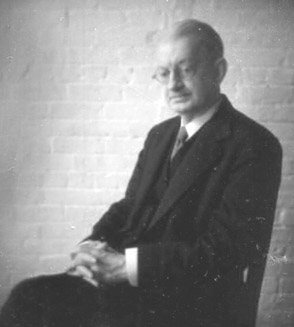
Most of his works were anthologies of verse, but no poem with a chess theme has been found. For references to the game it is necessary to turn to his autobiography, Troubadour (New York, 1925), which presented a vivid and not always attractive picture of New York chess during his youth. Page 20 states that his own full name was Alfred Francis Kreymborg, but in the book he frequently refers to himself in the third person by his nicknames ‘Ollie’ and ‘Krimmie’.
In New York his parents, Hermann and Louisa, ran a cigar store, in which his father kept a chessboard. Pages 33-35 describe the boy’s introduction to chess:
‘At first, these moves were a mystery, a terrible puzzle, a haunting invitation. His father had refused to teach him the game. “It’s not good for you – a boy who’s always sitting by the fire – chess is bad for the health.” So Ollie had to watch and calculate, with a concentrated stare that amused the customer, especially if the customer won – which he did whenever his opponent ventured an unsound sacrifice. Immediately to defend himself with the venerable dodge: “I had a won game before I made that mistake.” The boy watched and wondered until he learned where the pieces stand before the battle begins, and was permitted to set up his father’s men – much to the amusement of the customer, who would say: “Never mind, Junge, when you grow up, you’ll be able to play – your father’s right – you’re much too young to learn now.” But Ollie was not too young – not for chess.
He had already formed a pernicious habit – a lifelong habit – of teaching himself what he could not learn otherwise. ... He was undoubtedly what people call singular. Nothing but an abnormal entity – so it might have been inferred – would have stood up night after night, on an improvised pedestal, for the purpose of learning what those rooks, knights and bishops were doing. He never asked any questions; he was too shy, too self-centred for that. But continued to study and concentrate until he had mastered every turn of the moves. Ollie was nine years old at the time.
... [H]is father ... caught him setting up the chessmen, each right piece on its right square, and trying out moves on the sly, to see if they worked. The father was so foolish as to be proud of the sight, as he lifted the boy to the throne and urged one of the customers to challenge him. “Give the boy odds – a queen and two rooks – and let’s see what will happen.” They saw him improve and promoted him from the queen and two rooks to a queen and one rook. (“What do you think of the rascal?”) And then to a queen – the queen alone. (“How did he learn so fast? – it was only a few months ago – ”) Yes, he had learned fairly fast. First of all, when he lost, he had taken to weeping hysterically – until his father gave the customer the wink, and the latter made a mistake, and Ollie won a piece and smiled, and his opponent cried, “Potztausend, what shall I do – he plays too well.” Ollie tingled all over, found the checkmate – blundered into it – and felt like the King of Spain. Night after night he sat on the improvised throne, worked with all the small faculties at his command, silently, stubbornly, until the customer had made enough calculated blunders and Ollie enough uncalculated good moves for the former to cry, “Potztausend”, the boy to smile and feel warm, his father to exclaim with delight – and his mother to call: “Come, Ollie – go to bed – it’s late – and you haven’t studied your lessons.”’
A regular visitor to the Kreymborgs was ‘old Hirschfeld’. From page 42:
‘He was popular in the family because he never played, was an expert Kibitz or onlooker and maintained an air of enthusiastic detachment, no matter what happened on the battlefield – with an almost imperceptible predilection in Ollie’s direction whenever the boy made what looked like a good move. (With regard to such moves, Frank Marshall, the present American champion, once advised Ollie to beware of patriarchs who nod with every move you make – “If they do, you can be sure you’re playing like a duffer.”) Be that as it may, old Hirschfeld nodded behind Ollie fairly constantly, and added to it by stuttering and stammering the most extravagant praise.’
On pages 70-72 Kreymborg describes how he began to regard the game more seriously and was taken to the Evans Chess Club, which was named after ‘Captain Evans who kept a guardian eye on Ollie and eventually raised a fund among the members to provide the boy with the entrance fee to his first New York state competition – at the age of 15 or 16’:
‘Way down to Eighth Street, one of his father’s customers had taken Ollie, so he might meet a few “real players”, instead of the tyros who came into the store and hampered his development. That inconspicuous den down three stone steps started a chess career lasting, on and off, for the next 15 years.
How he loved the place and haunted it. How he stole downtown on every possible occasion and through every available subterfuge. How he adored the men who idolized him so. Some of them were ages older than he; some had white heads and beards; some were even older than his father. And yet, they sat down with him without hesitation, never patronized him, but pulled out their pipes or ordered a cigar and smoked so gravely as they puzzled over Ollie’s moves, one might have fancied a master opposed them. ...
There was no appeasing his appetite for chess. If he happened to lose a game, so much the worse for his passion. It redoubled its energies, enveloped every thwarted faculty, twisted him into a frantic devotee. The mania waylaid him at night, long after he went to bed, cornered him so completely that he could repeat moves in the dark, without the board in front of him. It was thus he learned to play blindfold, as it is called. At 15 or 16, he tried playing three games simultaneously against three much weaker opponents. Each of them had a board in front of him, while Ollie, seated in another room, memorized the moves they called out. He answered the moves well enough to carry off all three games and then – fainted. This climax frightened him out of the habit.’
Next, an extract from pages 115-117:
‘There were two places to which the young author directed himself in the interests of his income: the Rice Chess Club on the East Side, almost entirely frequented by Jews, and the Manhattan Chess Club in Carnegie Hall, with a large membership of affluent business men. At both clubs, because he played on their teams in matches against other clubs, he didn’t have to pay dues. ... Affecting nonchalance, Krimmie would wait for what other professionals in similar circumstances dryly called a customer. When that gentleman arrived, and one hoped he would prove to be the bull-headed, bull-necked prosecuting attorney, James W. Osborne, who played like a perpetual beginner and always lost like a gentleman, one sat down with him, offered him the odds of a queen, rook, knight or pawn and two moves, as his case warranted, and agreed on a dime or a quarter as the friendly side bet per game. ...
For the greater part of the next ten years, these jaunts provided the most regular source of Krimmie’s income. As to the intermittent irregularities ... they were taken care of in the form of prizes he won in tournaments. These sums mounted to ten, 20 and as much as 30 dollars at a time. But as most of the tournaments lasted for months and one had to sit down once or twice a week and stick to games which dragged into six, seven and eight hours at a stretch, the contests robbed one of every available ounce of nervous energy. In the last tournament in which Krimmie participated – an American national congress running every day for two or three weeks – he lost nine pounds. “That’s nothing”, Roy Black, the Brooklyn champion, challenged him; “I’ve lost 13”. Krimmie took part in tournaments everywhere: at the Rice Club, where the prizes were smaller and one inhaled the worst tobacco smoke; at the Manhattan Club, where the prizes were larger and one enjoyed the aroma of Havana cigars; or at the gatherings of the New York State Chess Association, at one of which he tied with José Capablanca, the present world’s champion, only to lose the play-off by the most heartrending of margins, due to the smallest of slips he committed in the endgame. In addition to the tournaments, there were those team matches with rival organizations. Krimmie rarely missed such contests and acquitted himself so much better than when he fought for himself and his necessity that he forsook chess with at least the one memory of never having lost a game where his club was concerned. They gave him a nickname for that: Old Reliable One because, in his early 20s, he was already “a battle-scarred veteran”.’
Pages 124-125 include an account of the squalour and penury to be found in certain chess circles:
‘Krimmie ... walked over to the Rice Club and played far into the small hours. ... He had gone to the Rice this time, in preference to the Manhattan, because of an instinct which prompted him, whenever he felt so low he could not conceivably fall lower, to seek the society of men worse off than himself. Steeped though he was in chess as a pastime, an opiate and an income, Krimmie had detached himself sufficiently ... to see those grubbing, groping mortals distinctly outside himself. And beholding them thus – young and old Jews who would never do anything except potter over chess – the sole kingdom they conquered and ruled till the Cuban Capablanca came along – Krimmie’s self-pity vanished. He watched and listened to them all: from the brilliant young experts, Jaffe, Tenenwurzel and Bernstein, Rosen, Rosenthal and Rosenzweig, up to those patriarchs, the ironic Rabbi Berenstein, Professor Rice, the inventor of the gambit everybody busted, and the antediluvian Doctor Gold, who had composed chess problems for 60 years and would compose them until he died. And down to the swarm of “dubs and duffers” who would never get anywhere; each one a hopeless Nebich who schemed and blundered, disputed and indulged in the entire lexicon of vituperation, only to find himself in still another deadly mate-trap. Knowing their plight – how some stole off to Houston Street late at night, into a café whose proprietor allowed them to sleep there, on the chairs or on or under the tables – Krimmie forgot his own gloom. One of them, a little too proud for such charity, preferred Union Square Park and lay with the bums on the benches, until a cop came along, tapped the soles of his shoes and shouted at him to move on – as he dutifully recounted to the Morgue when the body was brought there and, a day or two later, was identified by some of the other duffers and saved from Potter’s Field.’
Finally, pages 145-146 describe how Kreymborg’s enthusiasm for chess waned:
‘Although the Rice and Manhattan clubs, for the next year or two, were still his principal haunts at night, Krimmie was soon to participate in what proved to be his last tournament. He had begun to look upon chess with aversion, not alone because, as the philosopher Mendelssohn declared, “it is too much of a game to be a science and too much of a science to be a game”, but because it was still the total source of his income ... And chess continued to take so much out of him that he dreaded, almost hated it. Despite his many friends at the clubs, he dragged his way there less frequently and degenerated into what East Siders term a Kibitz, an onlooker. After so many staunch years of it, the game had grown tediously conventional. The invariable Queen’s Gambit and Ruy López attacks and French and Sicilian defences had been so thoroughly tested and perfected by the masters and so sedulously aped by the tyros that one had to have recourse to irregular openings for the sake of a little novelty. But the Hoboken Gambit, as Krimmie dubbed his favorite irregularity – opening with the absurd advance P-QKt4 – palled on him. The move had lost its whimsicality. Even the duffers employed it and, though they floundered about among the consequences, refused to return to the much safer haven of the classics. And so, “the latest thing” rapidly joined the oldest in the breeding of an inescapable monotony.
Most of all, the ambition to rise in the demesne of Caïssa no longer appealed to Krimmie. A good part of the way from childhood, he had seen visions of himself sitting down near the head of the procession in time and, after carrying off first honors in an international tourney in Budapest or Moscow, challenging Emanuel Lasker for the undisputed championship of the world. The inglorious defeat in such an event he now resigned to others – the French, German and American champions, Janowsky, Tarrasch and Marshall – and the incredible victory to José Capablanca, the smiling enfant terrible who, at the close of the late war, dragged the conqueror of Steinitz out of retirement and overwhelmed him down in Havana. In the earlier days, as far back as his late teens, Krimmie had met Dr Lasker, but not over the board. The small, dark German-Jew, with his passion for the advancement of chess everywhere, had honored the lad by undertaking several trips to the Bronx to help him found the Bronx Chess Club. Krimmie never forgot this courtesy; nor the champion’s favorite remark: “If you see a good move, don’t make it – look for a better one.” Idling about the now dreary rooms of the Rice and Manhattan clubs, he recalled the axiom and finally applied it to the game he had followed for nearly 20 years. Chess was no longer the best move on the board; nor was it even a good one ...’
Below is a portrait of Kreymborg autographed by him in our copy of The Poetry Society of America Bulletin, November 1951, page 5:
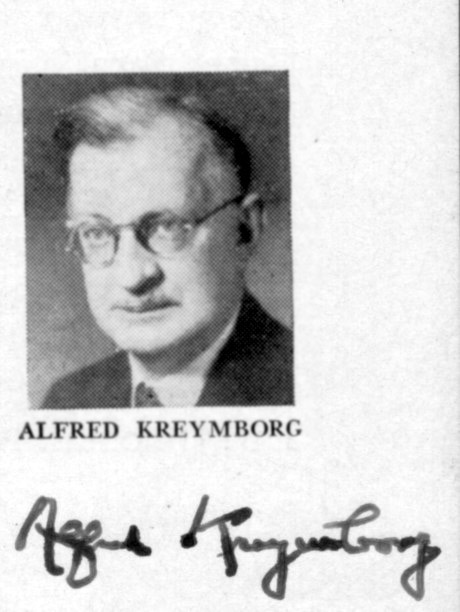
The other chess-related work by Kreymborg which is known to us (leaving aside his 1933 novel I’m No Hero, which has some chess content) is his play mentioned in C.N. 3484, Queen’s Gambit Declined. Subtitled ‘A Trio in Twilight’, it was included in the Samuel French anthology New Plays for Men & Boys (New York, 1935 and 1939). We are tentatively enquiring about being authorized to bring out a reprint, as a curio in a limited edition, although the text of a one-act play, only 14 pages long, may not arouse much interest.
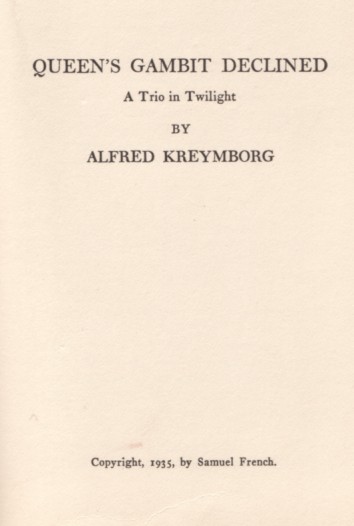
Our final word here is a reminder, and call to action, addressed to those with responsibility or influence regarding chess databases, so that anyone seeking games by Kreymborg is able to find them: there has never been a chess master named ‘Kreymbourg’.
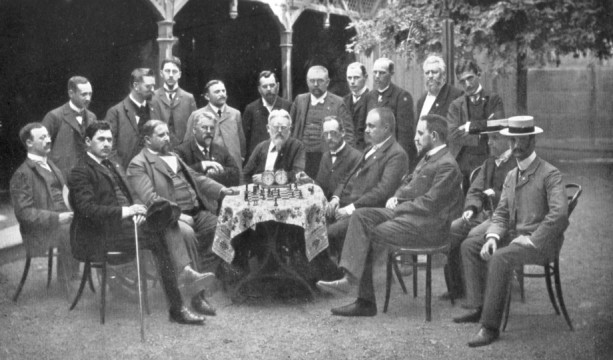
Standing (left to right): C. Schlechter, H.
Ranneforth, R. Swiderski, C. Schröder, A. Schott, F.
Tausch, W. John, H. Süchting, C. Teller, L. Fleischmann.
Seated: J. Mieses, H. Wolf, H. von Gottschall, P.
Schellenberg, R. Gebhardt, J. Berger, G. Marco, O. Bernstein,
C. von Bardeleben, H. Caro.
Maxwell Bukofzer (1875-1958) wrote a number of Sherlock Holmes stories with a chess theme, such as ‘The Adventure of the Mother-of-Pearl Buttons’ in the Chess Amateur, January 1925 (pages 123-125), February 1925 (pages 152-154) and March 1925 (pages 186-188), as well as passim in The Gambit in the late 1920s.
Page 81 of The Gambit, March 1928 reproduced the following from an unidentified publication:
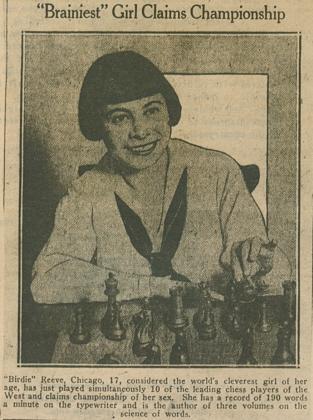
The caption reads:
‘“Birdie” Reeve, Chicago, 17, considered the world’s cleverest girl of her age, has just played simultaneously 10 of the leading chess players of the West and claims championship of her sex. She has a record of 190 words a minute on the typewriter and is the author of three volumes on the science of words.’
We quoted this feature back in the mid-1990s (see page 305 of Kings, Commoners and Knaves) but have never obtained further information about her or how such claims came to be made.
William I. Westervelt, Beverly W. Dunn and Charles E.
Kelley – Frank James Marshall
New York, 1928
Three Knights’ Game
1 e4 Nf6 2 Nc3 e5 3 Nf3 Bb4 4 Nxe5 O-O 5 Bc4 Qe7 6 f4 Nc6 7 Nxc6 bxc6 8 Qe2 Bxc3 9 bxc3 Nxe4 10 O-O d5 11 d3 Qc5+ 12 Be3

12...Nxc3 13 Qd2 d4 14 Qxc3 Resigns.
Source: The Gambit, April 1928, page 117.
The Kreymborg extracts in C.N. 3569 included a well-known remark about chess:
‘... as the philosopher Mendelssohn declared, “it is too much of a game to be a science and too much of a science to be a game”.’
Was it indeed the German philosopher and biblical scholar Moses
Mendelssohn (1729-1786) who made that observation? A similar
comment (‘Chess is too earnest for a game; too much of a game to
be earnest about.’) is attributed to his grandson, the composer
Felix Mendelssohn (1809-1847), on, for example, page 144 of Caissa’s
Web by G. Harwood (London, 1975).
From page 32 of Bobby Fischer The Wandering King by H. Böhm and K. Jongkind (London, 2004):
‘In 1969 Fischer’s book My 60 Memorable Games was published. It is a masterpiece, translated into all languages that are spoken in the member countries of FIDE (more than 125).’
This seems very strange. Our collection contains translations only into French, German, Italian and Russian, although the Cleveland library also lists a Greek edition published in Athens in 1985. Wanted: information on the book’s appearance in any other languages.
We commented in C.N. 3551 that Hubert Phillips ‘never wrote a chess monograph of his own’. That is certainly true, but it should have been added that his book Indoor Games For Two Players (London, 1961) had an extensive chapter on chess, followed by chapters on anagram chess, Welbeck chess, chess war games, draughts, go-bang, go and backgammon. On page 11 Phillips commented:
‘The game of chess must, I think, have pride of place in this collection of indoor games. No other indoor game is played with the same expertise and concentration throughout the civilized world. No other game has anything approaching its vast literature ...’
From our copy of Wereldschaaktoernooi Amsterdam 1950 by M. Euwe and L. Prins (Lochem, 1951), signed by all 20 participants:
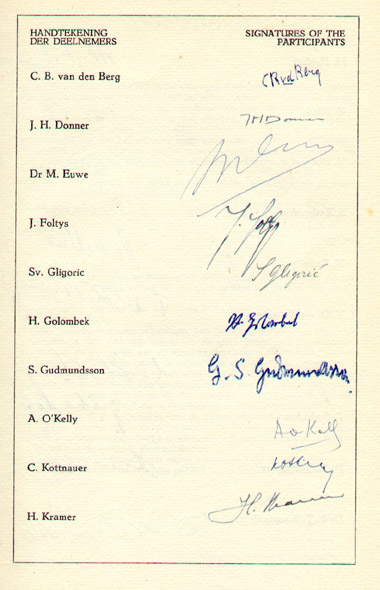

Readers are invited to ponder which prominent chess master wrote a book containing this (typical) page:
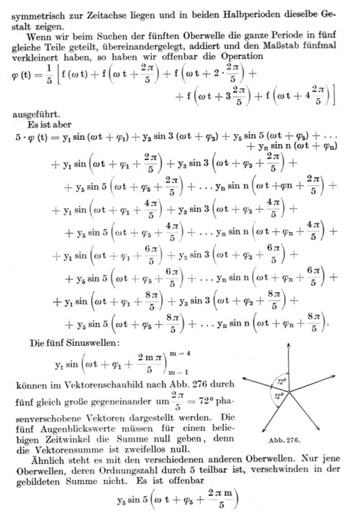
What is the shortest possible game (real or invented) in which
a player’s queen is trapped in the middle of the board? The
briefest specimen we have seen is in an Assiac book, but readers
are left for now to reflect upon the matter.
From page 208 of The Heel of Achilles by Arthur Koestler (New York, 1974):
‘... in his world championship match against the title-holder, Steinitz, Lasker asked to be seated at a separate table because old Steinitz sipped his lemonade with a loud noise (the umpire refused the request).’
Did such an incident occur? In C.N. 3266 we described Koestler as ‘an “intellectual” writer who put no scholarship into his chess writing’, and he was certainly prone to error. On the same page as the Steinitz/Lasker story, Damiano was described as ‘a Frenchman’.
C.N. 3566 asked about the origins of the ‘Variante Ovsey-Cotlar’. We had found it on pages 19-21 of Las defensas Lasker y Tarrasch by J. Ganzo (Madrid, 1957): 1 d4 d5 2 c4 e6 3 Nc3 Nf6 4 Bg5 Be7 5 e3 O-O 6 Nf3 h6 7 Bh4 Ne4 8 Bxe7 Qxe7 9 cxd5 Nxc3 10 bxc3 exd5 11 Qb3 Rd8 12 c4 Be6.
Calle Erlandsson (Lund, Sweden) writes:
‘Dr Mischa Cotlar, a well-known mathematician, was born in Kiev and settled in Uruguay. Later he became an honorary doctor in Buenos Aires. 12...Be6 is also called the Cotlar Counter-Attack. The first game with this variation that I know is Letelier v Reinhardt, Mar del Plata, 1946.’
Our correspondent also points out the following curriculum vitae: http://www.iam.conicet.gov.ar/cv/cvmischa.html
It may be asked where the ‘Ovsey’ comes in. At first we thought it a possible misprint or faulty transliteration by Ganzo, until noting that page 171 of the seventh edition of Modern Chess Openings by Walter Korn (London, 1946) has a footnote beginning, ‘But the most important contribution to the correctness of the defence is Ovsey Cotlar’s 12...Be6!!’. The supporting analysis in MCO was freely lifted by Ganzo, but we still wonder about the nature and extent of Cotlar’s involvement in the line, as well as the explanation for ‘Ovsey’.
In the ninth edition of Modern Chess Openings (published in 1957), enthusiasm for ‘Cotlar’s wild move’ was cooler, although it still received one exclamation mark (see page 189).
From Kevin Croxen (Cambridge, MA, USA):
‘The WorldCat bibliographic database of the Online Computer Library Center (OCLC) contains bibliographic records for two additional translations of My 60 Memorable Games: one into Chinese and one into Armenian.
Qi tan guai jie 60 ju. Lin Feng bian yi. Shanghai Shi: Shanghai yuan dong chu ban she, 1993. (8, 3, 3, 528 p. : ill.; 20 cm.) ISBN: 7805148821.
A contents note states that this volume consists of two sections entitled: “Qi tan guai jie Feishe’er” / Lin Feng; and “Wo nan wang de 60 ju” / Bobby Fischer, Lin Feng yi. The record indicates that the latter section is the translation.
Im arzhanahishatak 60 partianere. Robert Jeyms Fisher. Erevan: “Hayastan”, 1989. (341 p. : ill. ; 21 cm.) ISBN: 554000227X. As this is a Soviet-era imprint the colophon title is in Russian: Moi 60 pamiatnykh partii.’
If a reader can assist us in procuring these two editions, as well as the Greek one mentioned in C.N. 3575, we shall be most grateful.
Eliot Hearst (Tucson, AZ, USA) reverts to a matter he raised in C.N. 3329:
‘A few years before his death in 1983, János Flesch claimed in a written statement to John Knott that his 52-board blindfold display in Budapest in 1960 had been “duly ratified by FIDE as the new world record”. Can a FIDE official or other chess authority/historian tell us whether this claim is true and, if so, what other simultaneous blindfold records have been “ratified by FIDE”?’
Following the earlier appearance of these questions from Professor Hearst we wrote to FIDE, but our enquiry (dated 6 June 2004) received no reply.
Personal chess records (such as the number of opponents faced simultaneously and the oldest grandmaster) are a popular topic for discussion, but no effort seems to have been made, by any organization, publisher or individual, to list the facts systematically and dependably, in the way that Tim Krabbé has done for over-the-board records (such as the latest castling and the longest symmetrical game).
From Christian Sánchez (Rosario, Argentina):
‘Several websites suggest that the chessplayer of that name (and analyst of the variation) was, rather, the father of the mathematician Mischa Cotlar. For instance:
“La historia de Mis[c]ha Cotlar es muy interesante. De familia burguesa en Kiev, su padre – un hombre culto cuyo nombre figura en la historia del ajedrez con la variante ‘Lasker-Cotlar’ – emigró con toda la familia, el hijo adolescente, al Uruguay en 1929.” (http://www.rionegro.com.ar/arch200112/o04j02.html).
“A partir de la habilidad de su padre con el ajedrez, el nombre Cotlar llegó a oídos del Dr. La Guardia, (...) quien admitió al joven Mischa en sus clases.” (http://www.fcen.uba.ar/prensa/cable/2001/e-c434b.htm).
The Oxford Companion to Chess (page 95 of the 1992 edition) also goes in that direction.’
Mr Sánchez points out (as does Calle Erlandsson, Lund, Sweden) that, under the title Mis 60 mejores partidas, there exists a Spanish edition of Fischer’s My 60 Memorable Games. It was published by Editorial Fundamentos, Madrid.
To summarize, it is now known that there are translations into Armenian, Chinese, French, German, Greek, Italian, Russian and Spanish. Any more?
For the indolent and/or rapacious ‘publisher’ the simplest venture is to take an old book and reprint it as it stands, however many factual mistakes it is known to contain. A notable victim of this process has been a volume which, in so many respects, is lamentably inaccurate: Capablanca’s Hundred Best Games of Chess by H. Golombek (London, 1947). In recent decades it has been the subject of a number of push-button reprints, with no effort made to set the record straight.
One reprint was by the BCM, in 1989. For a summary of the magazine’s subsequent duplicitous conduct, see pages 268-269 of Kings, Commoners and Knaves. The then Editor of the BCM, Mr Bernard Cafferty, has never, to this day, apologized for deceiving his readers.
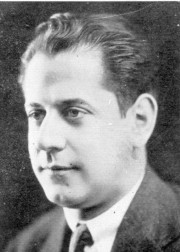
José Raúl Capablanca
In September 1996 John Nunn informed us that B.T. Batsford Ltd. was about to bring out an algebraic edition of the book, and he asked us if a list of known errors in the original could be provided. Within the limited time on offer we were happy to oblige, and our reply was eight pages long. The points listed ranged from relatively minor or debatable matters (such as faulty accents and transliterations) to all kinds of gross factual gaffes. Overall, we feel that Batsford made good use of our corrections in its algebraic production, Capablanca’s Best Games (London, 1996).
For the convenience of readers who possess only
the descriptive edition (either the original or one of the
insouciant reprints) and would welcome an errata list, our
letter of 29 September 1996 to Dr Nunn is reproduced here.
A candidate for the most famous of all quotes on the game is ‘Chess is a sea in which a gnat may drink and an elephant may bathe’, but is it authentic? This ‘Indian proverb’ may have an ancient ring to it, but we have found no appearance in chess literature until Norman Knight gave it on page 145 of his anthology Chess Pieces (London, 1949). It was then picked up by other writers (e.g. by Irving Chernev, on the inside front cover of Chess Review, September 1950 as the ‘thought for the month’).
Knight’s book had a chapter entitled ‘Chess in Proverb’, containing 14 alleged specimens. Among the others were:
No additional information was provided by Knight about the
origins of any of the above, and we find his entire chapter
profoundly unconvincing. All 14 alleged proverbs were served up
again on pages 226-229 of King, Queen and Knight by N.
Knight and W. Guy (London, 1975).
From pages 161-162 of Karpov on Karpov (New York, 1991), during a description of the mid-1970s discussions between Fischer and Karpov on a possible world championship match:
‘After the talks we set out for a stroll around Tokyo. I was afraid that autograph hounds would harass us, but, to my amazement, not one person approached us. Here were two of the best chessplayers in modern times, whose photographs practically never left the front page, walking down the street – you’d think at least someone would have noticed. Later I understood that such a thing is possible in only one place on earth: Tokyo.
One photograph – the only one in which Fischer and I are together – was taken. The chairman of the Japanese Chess Federation, Matsumoto, ingratiated himself with Fischer, who disliked journalists even more than their articles, and took our picture “for his family album”. A few days later the shot was sold to Agence France-Presse, who in turn distributed it worldwide.’
Somehow that photograph seems to have passed us by. Can any readers say where it has been published?
Chess Notes Archives:
| First column | << previous | Archives [5] | next >> | Current column |
Copyright 2005 Edward Winter. All rights reserved.
Copyright: Edward Winter. All rights reserved.